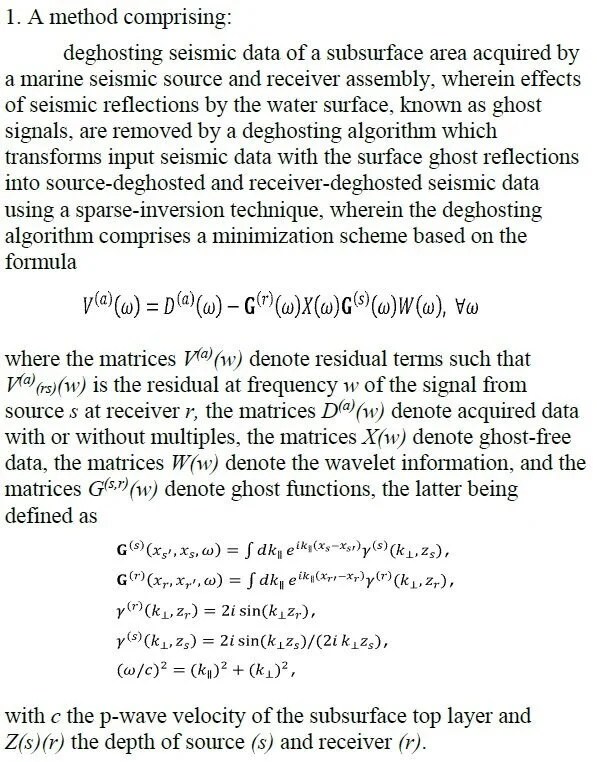Section 101 rejections come in many forms. Today we focus on the particular issue where an applicant (Shell) aims to claim a specific algorithm (a deghosting algorithm) applied to a particular practical application (analyzing seismic data of a subsurface area acquired by a marine source and receiver assembly). In such cases, Section 101 rejections are likely as an examiner will assert that the applicant is claiming a mathematical concept, which is a judicial exception. See MPEP 2106.04 and the 2019 Revised Guidance from the USPTO.
Shell’s deghosting approach (Application 14/441,225) was particularly valuable because it enabled deghosting of data acquired with less sophisticated (older) sonar, such that previously held data could be upgraded and re-evaluated (for off-shore drilling). In this way, the expense and time of acquiring new data of a particular subsurface location can be avoided.
Shell was solving a technical problem and did so using a novel algorithmic approach, thus it seems there is at least some chance for patent protection. Shell’s claim 1 is below:

The USPTO made no prior art rejections, and only rejected the claims under Section 101. Shell first tried to amend the claim to add a step of generating an image of the subsurface area and developing the subsurface area using the generated seismic image. Unfortunately for Shell, they had insufficient support in their specification for such features, as the specification largely reads like a technical paper and focuses entirely on the algorithm. As such, Shell was forced to revert to the original claim language that required only the step of deghosting seismic data (which essentially meant that Shell had little chance to argue against the claim reciting nothing more than an abstract idea).
Therefore, on appeal Shell argued, among other things, that the invention integrated the exception into a practical application. Shell laid out 4 reasons/advantages for practical integration of the abstract idea, pointing out that the invention:
-
does not require towing multiple streamers at different depths or using hydrophone data from different depths,
-
produces output data that exhibits a significant bandwidth broadening with respect to input and allows for pronounced improvement of subsequent imaging,
-
is applicable to previously acquired data sets, and
-
tackles both the source-ghost and the receiver-ghost in a single non-cascaded step.
However, none of these was sufficient on appeal. The PTAB responded to each point as follows (emphasis in bold added):
-
the Appellant’s claim does not exclude towing multiple streamers at different depths or using hydrophone data from different depths, and does not require obtaining hydrophone data at a single depth,
-
the significant bandwidth broadening and imaging uplift are the result of the transformation of input hydrophone data into its deghosted signal, which is a characteristic of the algorithm, not a practical application of it,
-
the Appellant’s claim does not exclude using newly acquired data sets, and the applicability to previously acquired data sets pertains to the source of the method’s seismic data, not to a practical application of the algorithm, and
-
tackling both the source-ghost and the receiver-ghost in a single non-cascaded step is a characteristic of the algorithm, not a practical application of it.
While each of these points is worthy of discussion, this posts focuses on the bolded aspect – the technical advantages that an applicant argues in support of integrating into a practical application should not merely be characteristics of the algorithm (abstract idea). However, knowing where to draw the line between the advantages related to a characteristic of the algorithm and the practical application of can be difficult. In the example above, every time Shell tried to go beyond the benefits of an algorithm in isolation, they were deflected away by the PTAB because those aspects were not part of the claim. Further, while the claim described that the seismic data was acquired in a specific way, that aspect was dismissed because “the prohibition against patenting abstract ideas cannot be circumvented by attempting to limit the use of [the idea] to a particular technological environment” under Alice/Bilski. Even the PTAB specifically noted that:
claim 1 has no limitations beyond the step of deghosting using an algorithm including recited equations. The claim does not actually recite a step that produces deghosted data but, rather, merely recites a deghosting algorithm comprising a minimization scheme based on an equation that provides residual terms.
So, be careful to present your arguments (and claims) in a way that the advantages/practical application can be tied to something more than merely a characteristic of the abstract idea/algorithm.

Leave a comment